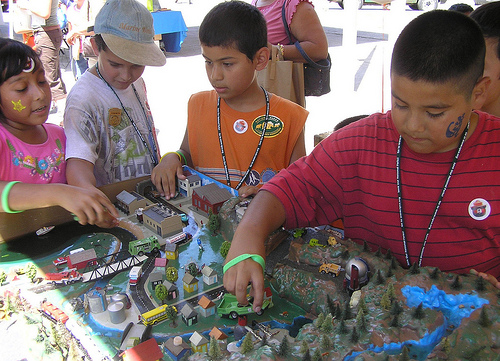The Internet is running out of it’s 4.3 billion Internet addresses! No fear, for IPv6 is here!
IPv6 is a new version of internet addressing that will replace the current IPv4 version. The new IPv6 format will allow for 340 undecillion addresses compared to 4.3 billion addresses under IPv4. The last batch of IPv4 addresses were allocated in February, 2011. Read more »
Baseball fans thrill at the thought of hearing a bat crack. But seeing an actual bat shatter is not one of those thrills. That’s because this seemingly harmless wood breaking can be dangerous for the players and fans and is the reason that the U.S. Forest Service Forest Products Lab has worked for several years to improve the strength of wooden bats.
The Products Lab’s efforts have not been in vain. Since Major League Baseball’s partnership with the Forest Service began in 2008 there has been an astonishing 50 percent reduction in multiple-piece failure rates in bats. Read more »

Children learning about watersheds.
Cross posted from the Let’s Move! blog:
Once again this year, U.S. Forest Service Chief Tom Tidwell is encouraging kids and their families to reconnect with nature and have fun by participating in the 4th annual National Get Outdoors Day (GO Day), on Saturday, June 11. This FREE event is designed to attract diverse communities to outdoor activities and motivate kids to get moving and explore their forests and other public lands. Read more »

NRCS Soil Conservationist Lane Kimbrough and landowner Orby Wright examine the growth of legumes in a longleaf pine forest.
Mississippians know the strength of longleaf pines. These native trees braved Hurricane Katrina 48 percent better than their loblolly cousins. Even so, the ancient longleaf pine forests of the South are a threatened ecosystem. Read more »
Cross posted from the Let’s Move! blog:
Today marks day two in the first ever National Summer Food Service Program Week, a weeklong awareness campaign to promote USDA’s Summer Food Service Program (SFSP) and other programs nationwide to feed low income kids.
Lots of things are happening around the country this week to help feed more hungry children this summer. For example today is National Hunger Awareness Day – as designated by the U.S. Senate in a bipartisan resolution. This is very fitting, given that at least 17 million children in the United States face a higher risk of hunger in the summer. Also today Agriculture Secretary Vilsack joined Jeff Bridges, Share Our Strength founder Bill Shore, Virginia Governor Bob McDonnell and others to launch Virginia’s No Kid Hungry Campaign at Barcroft Elementary School in Arlington, Virginia. Read more »
This post is part of the Science Tuesday feature series on the USDA blog. Check back each week as we showcase stories and news from the USDA’s rich science and research portfolio.
New research featured in the April/May 2011 issue of Science Findings, a monthly publication of the Forest Service’s Pacific Northwest Station, can assist efforts aimed at conserving potentially imperiled populations of the North American red fox. “When most people think of the red fox, they envision the ones that thrive in low-elevation, human-dominated landscapes,” said lead author Keith Aubry. “But there are other extremely elusive and rarely seen populations that live only in isolated alpine and subalpine areas in the mountains of the Western United States.” Read more »


